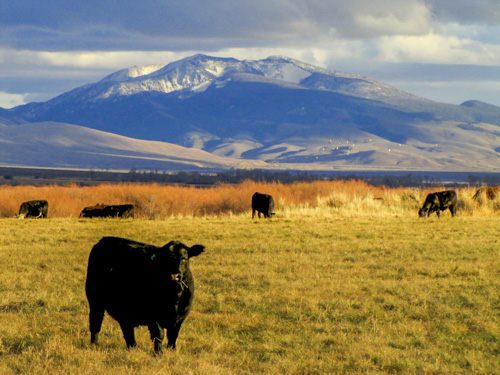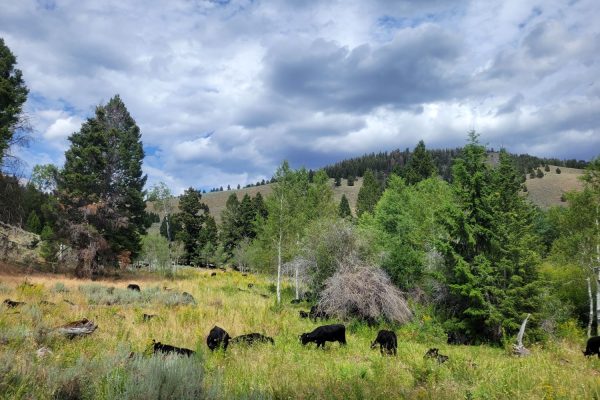 Newsletter from May 5, 2015
Newsletter from May 5, 2015There’s new snow on the rocky crest of the Lemhi Range today. It’s a fine landscape to watch the sun rise over as we are below normal on both mountain snowpack and rainfall. Our grass does look great, as do our ranges, but many folks in the west are in dire straits, and their drought is severe. When I check out the drought monitor map for the US, there is an ugly brown crater slicing through the middle of California: extreme drought severity.
It was beeve sorting day a few days ago. Every two weeks, we look at every steer in the herd to decide which ones are ready for the table. The next morning, we have an older couple, DaWayne and his wife Linda, haul them to the processor. DaWayne is a good hand at this, in spite of his 78 years, and knows how to work the beeves quietly. He has captured our vision of how we care for these animals after doing this for us every two weeks for 15 years.
We were running long that day, and as we picked out the last ones, clouds rolled in and the wind kicked up. We had 250 head that had to go back to the pastures in the fading light of another long spring working day. Springtime was actually the worst part about it because we would have to cross a super lush sward of green grass on the way back to their already grazed pasture
.
But the siren call of the lush stuff was more than they could stand just passing by, so they put their heads down. I was on April, our black mare who was pretty jumpy in the twilight wind, being helped by Cowboy Josh. Gyp and True, eager border pups cycled over the beeves’ heels hard. Even their barks and nips failed to get the attention of beeves with their noses in the fragrant grass. The beeves moved as fast as day old concrete.
It wasn’t a bad problem to have. Sure, it was after 10PM, and we had started very early that day, but I got almost as much pleasure watching those beeves wolf it down as they did eating it (I’ll have to admit part of the pleasure was being horseback on a quick-footed mare in the rain-spitting wind). It’s what we’ve all been waiting for after months of cold, bleak, and sometimes hopeless-feeling winter. Even the color green is redeeming for me. For the beeves, the color, taste and feel of the mixed grass and clover pastures is regenerative. They get a skip in their gait when the green wave comes; they lose winter hair; their coats shine and their ears perk. It affects the core of their being. Grass is good
.
And it is good for the land, too.
I visited with a friend from southern Idaho on Tuesday who was interested in purchasing a small farm down there. We talked about driving through that area and about how intensively it is farmed. He has a nephew that is a agrichemical dealer there, and he could quote how much this farmer or that was spending on agricultural chemicals while driving along. Many of them were in the high hundreds of thousands on chemical application (per year). Several were well over a million. Unbelievable. And the soil looked naked and hungry to me because of how empty it looked.
I correct myself: this is not soil. Soil is a living breathing mass of organic diversity. This was dirt, an empty medium, a matrix on which to place chemical amendments in furrow after mineral soil exposed furrow, to grow plants for food and forage.
In the context of drought, bare soil turns out to be an enormous moisture drain. I am so thankful that we have a grass and ground cover blanket in place, because without that, exposed soil can lose over 95% of its moisture from the drying winds of winter. I can take a shovel and dig in our sod and still find moisture (and worms!!), even in ground not irrigated since last fall. Sure, it is not dripping wet after our dry spring, but the plants are still able to grow. Without the natural cover of grass and the water retentive capability of organic matter in our living soils, we would be as dry as the Sahara. Or California.
The paycheck of grass permaculture is a resiliency that smooths out the epic mood swings of weather and climate. And those mood swings are not new. I used to conduct tree ring studies in Central Idaho forests. There has been drought and drench for at least 300 years recorded accurately in dendrochronology data. Assuming that weather is static is foolish when one is presented with the incontrovertible evidence that the pendulum has swung before”¦wildly at times.
Grass also means flavor, if the soil underneath is intact and there is a wild ecosystem of diversity both above the ground in plant life and below the ground in biodiverse organisms. This is why grass fed beef from tilled acreage (like those acres I spoke about above) lacks the full spectrum of flavor (or nutrition).







Leave a Reply